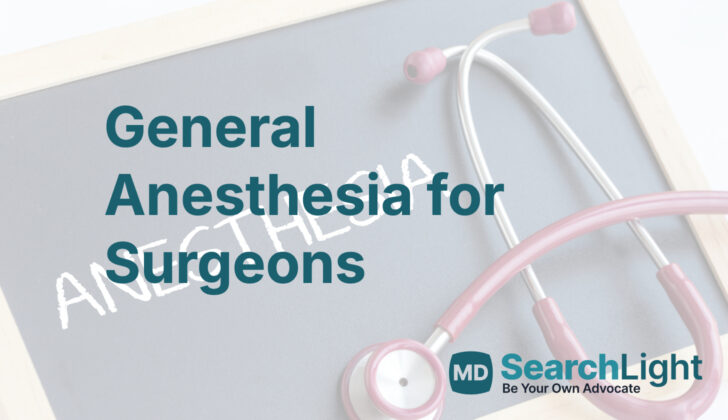Overview of General Anesthesia for Surgeons
The surgeon needs to be familiar with how general anesthesia works. The main purpose of general anesthesia is to make a patient unaware and unable to feel any pain during a procedure, whilst also managing automatic body responses. There are different types of medications used in anesthesia: IV (into the vein) anesthetics, gases you breathe in, IV sedatives, manufactured painkillers named opioids, and drugs that block muscle movement. Each of these types has its own strengths and weaknesses in achieving the main aim of general anesthesia. For surgeons, knowing how these different medications work and also being aware of potential adverse effects can be very helpful.
Why do People Need General Anesthesia for Surgeons
If you’re having a major surgery that needs you to be fully relaxed for a long time, or if the surgery could result in significant blood loss or affect your breathing, your doctor may recommend general anesthesia. This is a type of medication that puts you in a sleep-like state so you don’t feel any pain during surgery. General anesthesia is also often used if the surgery you’re having can’t be properly numbed using local or regional anesthesia, which only numb a specific part of your body.
Some people may need general anesthesia even for minor procedures if they can’t keep still or cooperate during the surgery. You can also choose to have general anesthesia if you prefer it over other types of anesthesia options. Remember, your doctor will only recommend it if there aren’t any reasons why you shouldn’t have it.
When a Person Should Avoid General Anesthesia for Surgeons
In simple terms, there are no absolute reasons to prevent a patient from receiving general anesthesia, which is a medicine that puts you to sleep during surgery, unless the patient themselves refuse it. However, there are several factors that might make it less safe or ideal (referred to as relative contraindications).
These factors could include patients whose health conditions haven’t been fully managed before a planned surgery; patients who have other severe health conditions, such as serious heart valve disease (severe aortic stenosis), major lung disease, congestive heart failure (CHF); or those scheduled for a procedure that could be done with a different anesthesia technique which avoids manipulating the airway and changes associated with general anesthesia.
Before they are put under general anesthesia, patients should go through a pre-surgery check with the anesthesiologist. They’ll review the patient’s previous experiences with anesthesia, existing health conditions, the function of the vital organs like the heart, lungs, and kidneys, and check whether the patient is pregnant or a smoker. If possible, the doctors will also do their best to optimize the patient’s health conditions before surgery. For instance, a patient with unstable angina, a heart condition, might need a heart procedure before they have elective surgery.
While not absolute barriers to general anesthesia, it is crucial to identify if a patient or their family has a history of malignant hyperthermia (a reaction to anesthesia that causes a high fever and muscle contractions) and pseudocholinesterase deficiency (a condition that affects the breakdown of certain drugs used during anesthesia). This is essential information to have because these medical conditions need special planning to reduce any risk or health complications if general anesthesia is needed.
Equipment used for General Anesthesia for Surgeons
General anesthesia is a state of unconsciousness that is often induced for surgeries and it uses certain equipment. This vital equipment includes a machine which carries out essential functions like aiding a patient’s breathing, regulating gas supply, and managing the levels of anesthetic administered, amongst other tasks. It also serves as a monitor displaying the patients’ key health signs.
Tools designed to manage and safeguard the patient’s airway, such as a face mask, laryngoscope (an instrument to observe the voice box), endotracheal tubes (tubes inserted into the windpipe to assist breathing), styles, and oral or nasal airways are also necessary. The size of the endotracheal tube used depends on the measurement of the inner diameter of the tube, with a 7.0 tube typically used for adult females and a size 8.0 for adult males.
For patients with complex airway issues, extra equipment should be on hand, like a video laryngoscope (a tool to visualize the voice box on a screen), a flexible fibre-optic scope (a tube with a light used to examine areas inside the body), an Eschmann catheter (a tube for suction or delivering fluids), a laryngeal mask airway (a medical device that keeps a patient’s airway open), and a cricothyrotomy kit (emergency airway equipment). This makes sure the doctors are prepared for any situation that may arise.
Who is needed to perform General Anesthesia for Surgeons?
An expert who can give patients medicine to help them sleep during surgery is required to check and keep an eye on patients who are receiving this type of sleep medication. The people who can do this role include professionally approved anesthesiologists (doctors who specialize in this type of medication), medical students in training, and specialized nurses known as certified registered nurse anesthetists.
Preparing for General Anesthesia for Surgeons
Surgeries are categorized based on urgency into four groups: elective, semi-elective, urgent, and emergency. Elective surgeries do not involve a medical emergency and can be planned in advance. Semi-elective surgeries, though important for preserving a patient’s life, are not required to be performed immediately. Urgent surgeries, however, are recommended to be performed within one to two days but can be delayed briefly to allow the patient’s health to stabilize. Lastly, emergency surgeries are those that must be carried out immediately to reduce the risk of permanent disability or even death.
Having this classification helps doctors determine whether the surgery needs to occur sooner or can be delayed, depending on the patient’s condition or their recovery from another medical procedure. Ideally, doctors would want the patient to be in their best health condition before undertaking surgery requiring general anesthesia.
Additionally, it’s helpful for the surgeon to have a discussion with the anesthesiologist before any surgery. They discuss details about the procedure, how long it’s expected to take, the patient’s positioning, the level of anesthesia needed, risk of possible blood loss, and whether muscle relaxants or medications to control blood pressure are available to use. This conversation helps them form a better plan for proceeding with the anesthesia. If the surgeon knows the patient has a history of complications with anesthesia or significant medical conditions that could affect the anesthesia plan, they should share this information with the anesthesiologist.
Possible Complications of General Anesthesia for Surgeons
Using general anesthesia during surgeries often leads to side effects. These can range from temporary confusion and memory loss, feeling dizzy, difficulty in urinating, feeling nauseous and vomiting, feeling cold, and having a sore throat. Patients who are older or have serious health conditions and are going through longer procedures have a higher chance of facing severe complications. These severe complications can include ongoing confusion, memory loss, heart attacks, lung infections, blood clotting, and strokes.
However, it’s important to note that death due to the use of general anesthesia is very uncommon. The chances are estimated to be around one in 150,000 people. So while side effects and complications are possible, the risk of a fatal outcome is extremely low.
What Else Should I Know About General Anesthesia for Surgeons?
Being sedated or “put to sleep” for surgery often involves the use of drugs called general anesthetics. There are two main types: intravenous (through a vein) and inhalational (breathed in). The specific medicine and dose depend on your particular situation.
Intravenous anesthetics are usually used first because they put you to sleep quickly. These are often followed by inhalational anesthetics to keep you asleep during surgery. One common intravenous anesthetic is Propofol, which is fast-acting and causes you to wake up quickly without feeling groggy. However, it can slow down your breathing, so monitoring is essential. Another intravenous anesthetic called ketamine distorts your perceptions and detaches you from your surroundings, but it can also increase secretions and risk of spasms in the voice box, and even cause hallucinations. Others like Etomidate and Dexmedetomidine have their own pros and cons.
Inhalation anesthetics are gases that you breathe in. They are absorbed by your lungs and the concentration in your brain is directly related to how much is in your lungs. They are often used to maintain anesthesia during the course of surgery. Nitrous oxide is one type, but it doesn’t usually provide full anesthesia on its own, so other drugs are added. Other inhalation anesthetics include sevoflurane and desflurane, which help you to wake up quickly after surgery. However, in rare cases, these drugs can trigger a severe reaction called malignant hyperthermia, especially in people with a family history of this condition.
There are also a group of drugs called benzodiazepines, which are used before surgery to lessen anxiety and promote sedation. An example is Midazolam, which can help you relax and forget about the procedure. But all benzodiazepines can suppress the body’s response to high levels of carbon dioxide in the blood, so care is needed in patients with conditions like COPD, where breathing can already be a challenge.
Synthetic opioids, which are powerful versions of drugs like morphine, and more, can provide intense pain relief. But they also have side effects like small pupils, slow breathing, slow heart rate, constipation, and difficulty in urinating, and can potentially cause severe difficulty in breathing and stiffness of the chest wall.
Another group, called neuromuscular blocking drugs, are used to induce muscle relaxation. For example, succinylcholine is well known for its quick and short-term paralyzing effect. However, careful usage is necessary as it may cause an adverse reaction, especially in children with undiagnosed muscle diseases. Other neuromuscular blocking drugs like vecuronium and rocuronium work by competing with a chemical in the body, acetylcholine, at the junction between nerve and muscles, rendering muscles temporarily unable to respond to nerve signals, and hence relaxed.
In general, the choice of drug and dosage used during anesthesia is carefully adjusted based on various factors by your anesthesiologist.












